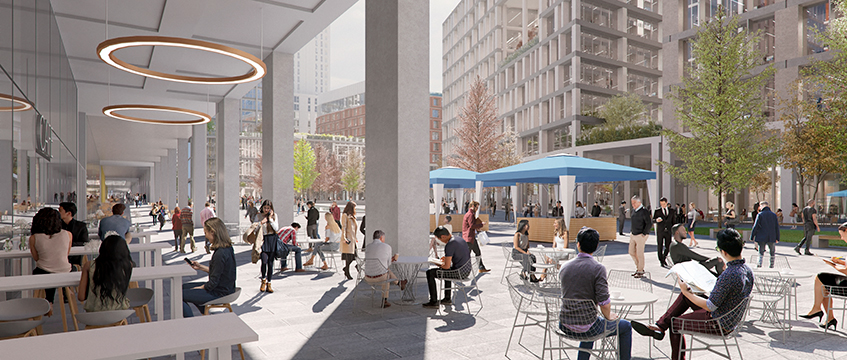Imperial seeks £1bn jv partners as R&D investment soars
Imperial College is looking for further joint venture partners to deliver its £1.3bn White City campus expansion.
The masterplan, a 2.5m sq ft proposal to develop the 14-acre site located south of the Westway on Wood lane, was approved by the London Borough of Hammersmith & Fulham last month.
Imperial is now looking to co-develop the south campus expansion with a property developer, a corporate in a relevant field, or both.
Imperial College is looking for further joint venture partners to deliver its £1.3bn White City campus expansion.
The masterplan, a 2.5m sq ft proposal to develop the 14-acre site located south of the Westway on Wood lane, was approved by the London Borough of Hammersmith & Fulham last month.
Imperial is now looking to co-develop the south campus expansion with a property developer, a corporate in a relevant field, or both.
Neil Alford, associate provost for academic planning, said: “It may not be just with a property developer, supposing we had a large corporate saying that they would like to locate here. But it would have to be the right company, focused on science, engineering or medicine.
“We have turned away companies that don’t fit. We would never sell the property; we want to maintain rights to the property, and develop it with people.”
The scheme is an extension to the north campus, which is under construction on the other side of the Westway.
The university has already entered into a jv with digital venture builder Blenheim Chalcot to build a meanwhile structure at the south campus. Scale Space will be a 200,000 sq ft new technology and innovation centre, which could contain up to 50,000 sq ft in laboratory space. The first phase of Scale Space is due to open in 2020.
Imperial also wants to develop 373 homes, a hotel, cafes, restaurants and leisure space on the site.
Together, the north and south campuses will total more than 4m sq ft, and the expansion will take around 22 years to complete.
The university has also engaged with Ealing Council over a potential opportunity to scale the White City innovation district, which currently forms part of Hammersmith & Fulham Council’s industrial strategy in partnership with Imperial.
Imperial has told the council that this district could expand to a wider area with the development of more laboratory space for start-ups, scale-ups and corporates.
New demand
Imperial’s desire to expand comes as a new wave of London-based entrepreneurs are shaking up the UK’s £70bn health and life sciences sector.
However, the capital’s property market is struggling to provide them with the research space they need. Currently, the supply of purpose-built London laboratory space, excluding retrofitted space, is only 100,000 sq ft, compared with 6m sq ft in Cambridge, 14.6m sq ft in Boston and 28.1m sq ft in San Francisco, according to Savills.
But this looks set to change as venture capital pours into new medical start-ups in London and supports their rapid growth.
Global venture capital flowing into digital health, healthtech and life sciences firms headquartered in London has already hit £601.6m for the year to date, up 55% from £389m the year before, and marking a significant resurgence on the £16.7m recorded in 2008, according to data from Savills and PitchBook.
Some landlords have made efforts to house the new mix of health start-ups as well as larger corporates that are relocating to London.
Stanhope, Mitsui Fudosan and AIMCo’s White City Place development will soon become home to Swiss pharma giant Novartis, which will relocate its UK head office from Surrey to the London scheme. Novartis will join fellow life sciences firms Autolus and Synthace at White City Place, and the move will put the company next door to Imperial’s new campus.
Stanhope property director Charles Walford said: “Young scientists can now make their mark and get money from venture capital more easily and grow very quickly. Autolus started off at Imperial with around five people in 2016, and they now have more than 300.
“The big pharma companies also can’t afford to do their own research any more so they want to attract young people into the businesses – they want to be close to them.”
Meanwhile, residential developer City & Docklands is exploring integrating labs at its 578-home One West Point scheme, in North Acton.
The firm’s chief executive, Gary Sacks, said: “We always intended to have an incubator. This initially started off as proptech in North Acton but [during an Ealing Council committee meeting] Imperial College said the area requires more laboratory space.”
However, Sacks added that the economics of adding labs to the scheme may be challenging. “I don’t know whether it is worth spending money on medical pharma space. I don’t know yet what the requirements are and how we can get a return.”
Stanhope’s Walford concluded: “It is not a vanilla building spec; that’s the rub for landowners and developers. There is extra design involved with putting lab-enabled offices into the base building.”
To send feedback, e-mail anna.ward@egi.co.uk or tweet @annaroxelana or @estatesgazette











